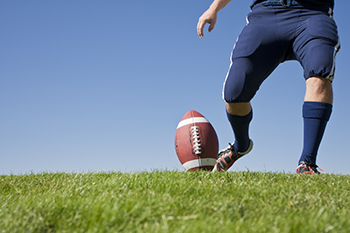Items filtered by date: October 2025
Heel Pain in the Morning?
How Does a Blister Form?
 Blisters that develop on the feet can make it difficult to walk and complete daily activities. When the skin is irritated, the body’s natural healing response is to protect the damaged area by forming a small bubble over it that is filled with fluid. As new skin develops, the blister will gradually drain, and is no longer needed. Blisters generally develop from excess friction that is caused by wearing shoes or socks that do not fit correctly. Additional reasons why they can form can come from existing medical conditions such as psoriasis and eczema. Effective prevention techniques can include wearing comfortable shoes, checking the feet for signs of rubbing, and removing the shoes if discomfort is felt. If you would like additional information about how to treat and prevent blisters, please consult with a podiatrist.
Blisters that develop on the feet can make it difficult to walk and complete daily activities. When the skin is irritated, the body’s natural healing response is to protect the damaged area by forming a small bubble over it that is filled with fluid. As new skin develops, the blister will gradually drain, and is no longer needed. Blisters generally develop from excess friction that is caused by wearing shoes or socks that do not fit correctly. Additional reasons why they can form can come from existing medical conditions such as psoriasis and eczema. Effective prevention techniques can include wearing comfortable shoes, checking the feet for signs of rubbing, and removing the shoes if discomfort is felt. If you would like additional information about how to treat and prevent blisters, please consult with a podiatrist.
Blisters are prone to making everyday activities extremely uncomfortable. If your feet are hurting, contact One of our podiatrists of Diagnostic Foot Specialists. Our doctors can provide the care you need to keep you pain-free and on your feet.
Foot Blisters
Foot blisters develop as a result of constantly wearing tight or ill-fitting footwear. This happens due to the constant rubbing from the shoe, which can often lead to pain.
What Are Foot Blisters?
A foot blister is a small fluid-filled pocket that forms on the upper-most layer of the skin. Blisters are filled with clear fluid and can lead to blood drainage or pus if the area becomes infected.
How Do Blisters Form?
Blisters on the feet are often the result of constant friction of skin and material, usually by shoe rubbing. Walking in sandals, boots, or shoes that don’t fit properly for long periods of time can result in a blister. Having consistent foot moisture and humidity can easily lead to blister formation.
Prevention & Treatment
It is important to properly care for the affected area in order to prevent infection and ease the pain. Do not lance the blister and use a Band-Aid to provide pain relief. Also, be sure to keep your feet dry and wear proper fitting shoes. If you see blood or pus in a blister, seek assistance from a podiatrist.
If you have any questions, please feel free to contact our offices located in Houston, TX, Houston, TX, and Bryan, TX . We offer the newest diagnostic and treatment technologies for all your foot care needs.
How to Fall Proof Your Home and Protect Your Feet

Fall-proofing your home is an important step in preventing injuries, especially foot and ankle problems. Begin by checking the front steps for cracks or uneven surfaces, and ensure good lighting around the front door for safe entry. Installing grab bars near the door provides extra stability. Additionally, use rubber-backed rugs to avoid slipping and always clean spills immediately to reduce hazards indoors. Falls can lead to sprains, fractures, or long-term foot pain. A podiatrist can evaluate injuries, provide treatment, and recommend supportive footwear or orthotics. If you have sustained a foot or ankle injury from falling, it is suggested that you schedule an appointment with a podiatrist who can treat various foot conditions, and guide you on additional fall prevention tips.
Preventing falls among the elderly is very important. If you are older and have fallen or fear that you are prone to falling, consult with One of our podiatrists from Diagnostic Foot Specialists. Our doctors will assess your condition and provide you with quality advice and care.
Every 11 seconds, an elderly American is being treated in an emergency room for a fall related injury. Falls are the leading cause of head and hip injuries for those 65 and older. Due to decreases in strength, balance, senses, and lack of awareness, elderly persons are very susceptible to falling. Thankfully, there are a number of things older persons can do to prevent falls.
How to Prevent Falls
Some effective methods that older persons can do to prevent falls include:
- Enrolling in strength and balance exercise program to increase balance and strength
- Periodically having your sight and hearing checked
- Discuss any medications you have with a doctor to see if it increases the risk of falling
- Clearing the house of falling hazards and installing devices like grab bars and railings
- Utilizing a walker or cane
- Wearing shoes that provide good support and cushioning
- Talking to family members about falling and increasing awareness
Falling can be a traumatic and embarrassing experience for elderly persons; this can make them less willing to leave the house, and less willing to talk to someone about their fears of falling. Doing such things, however, will increase the likelihood of tripping or losing one’s balance. Knowing the causes of falling and how to prevent them is the best way to mitigate the risk of serious injury.
If you have any questions, please feel free to contact our offices located in Houston, TX, Houston, TX, and Bryan, TX . We offer the newest diagnostic and treatment technologies for all your foot care needs.
Tackling Ankle Injuries in Football

Ankle injuries are among the most common problems faced by football players, often resulting from quick pivots, tackles, or falls. Sprains, strains, and fractures can occur when the ankle twists or rolls beyond its normal range of motion. These injuries are usually caused by player collisions, poor field conditions, or inadequate footwear. Symptoms may include pain, swelling, bruising, and difficulty bearing weight. A podiatrist can evaluate the injury through physical exams and imaging scans, then provide personalized treatment, such as bracing, rehabilitation, or custom orthotics, to restore stability and prevent reinjury. If you have suffered an ankle injury while playing football, it is suggested that you schedule an appointment with a podiatrist who can offer appropriate treatment solutions for ankle pain.
Ankle and foot injuries are common among athletes and in many sports. They can be caused by several problems and may be potentially serious. If you are feeling pain or think you were injured in a sporting event or when exercising, consult with One of our podiatrists from Diagnostic Foot Specialists. Our doctors will assess your condition and provide you with quality foot and ankle treatment.
Common Injuries
The most common injuries that occur in sporting activities include:
- Achilles Tendonitis
- Achilles Tendon Rupture
- Ankle Sprains
- Broken Foot
- Plantar Fasciitis
- Stress Fractures
- Turf Toe
Symptoms
Symptoms vary depending upon the injury and in some cases, there may be no symptoms at all. However, in most cases, some form of symptom is experienced. Pain, aching, burning, bruising, tenderness, tightness or stiffness, sensation loss, difficulty moving, and swelling are the most common symptoms.
Treatment
Just as symptoms vary depending upon the injury, so do treatment options. A common treatment method is known as the RICE method. This method involves rest, applying ice, compression and elevating the afflicted foot or ankle. If the injury appears to be more serious, surgery might be required, such as arthroscopic or reconstructive surgery. Lastly, rehabilitation or therapy might be needed to gain full functionality in the afflicted area. Any discomfort experienced by an athlete must be evaluated by a licensed, reputable medical professional.
If you have any questions please contact our offices located in Houston, TX, Houston, TX, and Bryan, TX . We offer the newest diagnostic and treatment technologies for all your foot and ankle needs.
Understanding and Managing Athlete’s Foot

Athlete’s foot is a common fungal infection that affects the skin of the feet, most often between the toes. It thrives in warm, moist environments such as locker rooms, public showers, and sweaty shoes. Symptoms may include itching, redness, peeling, or cracking skin, sometimes with a burning sensation. In more persistent cases, the infection can spread to the toenails or other areas of the body. Preventive steps include keeping feet clean and dry, wearing breathable socks, and avoiding walking barefoot in public places. Over-the-counter antifungal creams or sprays often provide relief, but stubborn infections may require prescription treatment. Because untreated athlete’s foot can return or spread, consistent care is important. If you are dealing with ongoing irritation or suspect athlete’s foot that is not improving, it is suggested that you consult a podiatrist for proper diagnosis and management.
Athlete’s foot is an inconvenient condition that can be easily reduced with the proper treatment. If you have any concerns about your feet and ankles, contact One of our podiatrists from Diagnostic Foot Specialists. Our doctors will treat your foot and ankle needs.
Athlete’s Foot: The Sole Story
Athlete's foot, also known as tinea pedis, can be an extremely contagious foot infection. It is commonly contracted in public changing areas and bathrooms, dormitory style living quarters, around locker rooms and public swimming pools, or anywhere your feet often come into contact with other people.
Solutions to Combat Athlete’s Foot
- Hydrate your feet by using lotion
- Exfoliate
- Buff off nails
- Use of anti-fungal products
- Examine your feet and visit your doctor if any suspicious blisters or cuts develop
Athlete’s foot can cause many irritating symptoms such as dry and flaking skin, itching, and redness. Some more severe symptoms can include bleeding and cracked skin, intense itching and burning, and even pain when walking. In the worst cases, Athlete’s foot can cause blistering as well. Speak to your podiatrist for a better understanding of the different causes of Athlete’s foot, as well as help in determining which treatment options are best for you.
If you have any questions please feel free to contact our offices located in Houston, TX, Houston, TX, and Bryan, TX . We offer the newest diagnostic and treatment technologies for all your foot and ankle needs.

